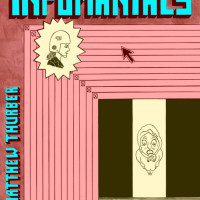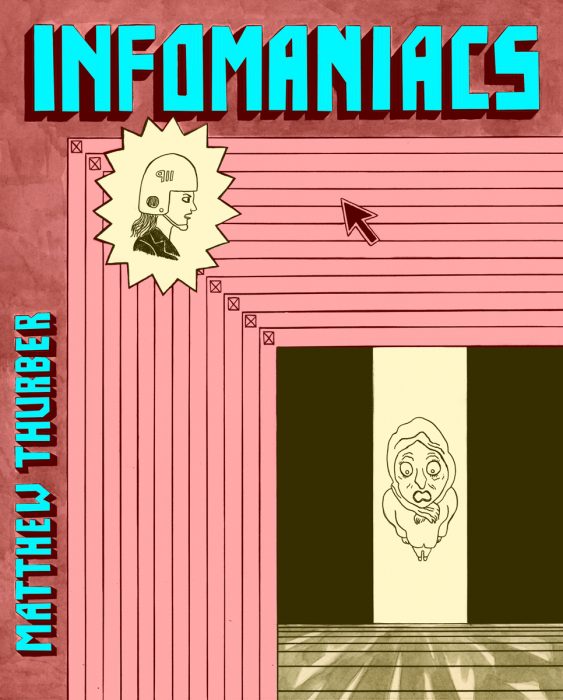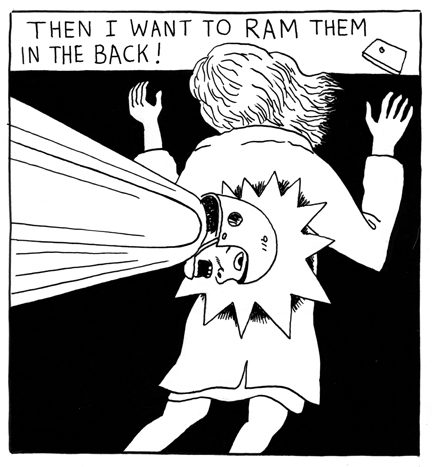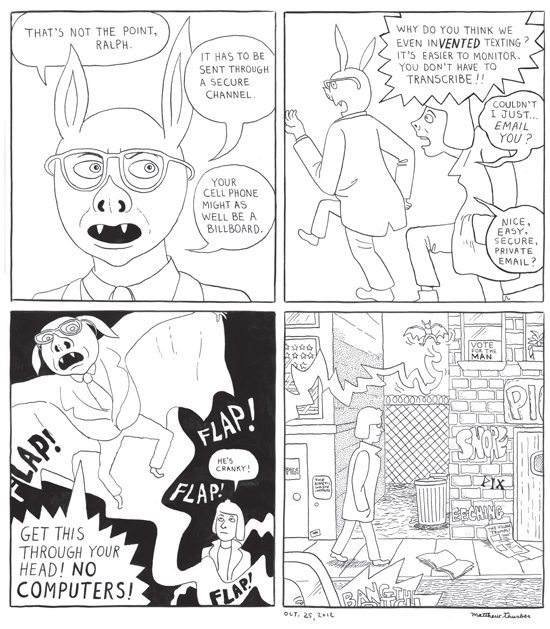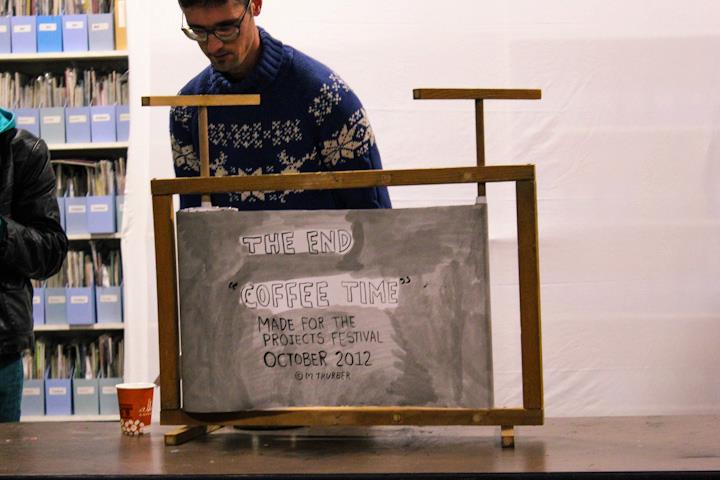The New York Comics & Picture-Story Symposium is a weekly forum for discussing the tradition and future of text/image work. Open to the public, it meets Tuesday nights from 7-9 p.m. EST in New York City. Presentations vary weekly and include everything from historical topics and technical demonstrations to creators presenting their work. Check out upcoming meetings here.
At the 77th meeting of the New York Comics and PictureStory Symposium, Matthew Thurber discussed INFOMANIACS, his comic about a mad but not so unrealistic future in which the internet has become even more ubiquitous. Thurber, who in addition to being a cartoonist works as a multimedia artist, performer, and musician, also gave a reading/performance of his scroll, Coffee Time.
Thurber began by clicking a file to open his presentation, only to have about thirty browser windows pop open. He seemed annoyed as he poked through them, looking for the one that had the visuals for his presentation in it. Something by Schubert began playing as he moved the windows around and commented on the existential sticking points of being constantly wired in, a great performative nod to the theme of INFOMANIACS.
He spoke about various social networking images and how absurd they were, including a Twitter ad that featured a number of silhouettes enjoying an evening on a rooftop overlooking a city. Thurber wondered what the image had to do with Twitter, and if maybe they were all just about to jump off the edge. He gave insights into his own struggles with oversharing and commented on the “geometric beauty” of viral and exponential growth. For instance, he recently quit Facebook, only to be sucked into checking Twitter and Tumblr incessantly.
INFOMANIACS, small art-comics press Picturebox’s final book, is both Thurber’s logical response to what he sees the internet doing to the world and a place to air his own feelings of frustration on the subject matter. He teaches a class of Millenials, who grew up with the internet. He seems equally perplexed and curious about their easy relationship with it. He did some internet research on the subject, specifically citing message board flame wars, which he called the “posthuman,” soulless side of Millenials, and the now-defunct avant garde comics blog, Comets Comets, the cold, academic tone of which he respected despite his proclivity for liveliness and humor in his own work. Thurber described a feeling of “lethargy” toward computers and digital media, and mentioned a number of times the familiar desire to bash in one screen or another.
The main characters of INFOMANIACS are Ralph, a social media addict with an ushnisha-like appendage growing from his head (second image, above), and Amy Shit, an activist rapper who rages against the state (third image, directly above). The plot follows both of them separately as a virus in the form of a strange cursor spreads and erases people’s digital identities. A man named Victor Valkyrie, who seems equal parts Donald Trump and Peter Thiel, tries to get the law to view the perpetrator as a serial killer, arguing that since more than 50% of people’s time is spent online, their whole lives are essentially being destroyed.
Ralph is more of a victim of the times, placed first into “Reality Rehabilitation,” something like a concentration camp for internet addicts, then betrayed by various individuals as he is handed off like a pawn between the powers that be. Amy Shit, on the other hand, whose name Thurber likes because it “normalizes” an obscenity, expresses the emotion he feels unable to act on in real life; she gives voice to Thurber’s anger at what the internet has done to people. Other plot points include an organic server farm, talking-animal CIA agents, and “The Man Who Has Never Seen the Internet”, who is not anti-technology, but just never happened across a computer on the Greek island where he lives. Thurber also let the audience in on a few backstage secrets of INFOMANIACS, such as one of the characters being a caricature of cartoonist Marc Bell.
Thurber’s love for old school gags and more contemporary art comics is evident in INFOMANIACS. He mentioned Gary Panter’s Jimbo series as a specific influence on the way the linework gets tighter over the course of the story. The film Children of Men inspired him to give INFOMANIACS a “maguffin” that would make the reader “embrace the paranoia” in the form of The Man Who Has Never Seen the Internet. The original Tinker Tailor Soldier Spy was also important, because, Thurber said, “everyone’s a spy now on Facebook.” Formative influences on his drawing style include John Tenniel, Gustave Dore, and Edward Gorey. He read a lot of Prince Valiant comics from the thirties while he was making INFOMANIACS. Thurber also mentioned Lucio Fontana’s “slash” series, in which the artist would slash through a usually blank canvas, as part of the inspiration for the viral cursor in the story that sucks people in “like a black hole.”
Though a number of art-comics intelligentsia eschew plot altogether, Thurber is fond of using it in his stories. He acknowledged that plot is an “artificial and contrived” device in storytelling, and likes it not just in spite of that, but because of it. Internal logic is great for narrative, he added, but if an idea is good enough, then ditch the rules and go for it.
After a brief intermission, Thurber brought out the scroll containing his comic Coffee Time on a wooden roller stand, which he lit from behind so the audience could see the art on the thin paper in the dark. He then began using the device to roll through it while narrating the contents in a dramatic voice. The result was a hysterical and captivating performance about a man whose seemingly mundane life unfurls in increasingly absurd ways. I could recount the details of Coffee Time’s plot and Thurber’s performance of it here further, but it is really better witnessed offline.
Images from top:
1: The cover of INFOMANIACS, by Matthew Thurber, Picturebox, Inc., 2013
2: Panel from INFOMANIACS
3: Panel from INFOMANIACS
4: Page from INFOMANIACS
5: Page from INFOMANIACS
6: Matthew Thurber performing Coffee Time at a previous event
–––––
About the author: Jess Worby is a professional illustrator, cartoonist, visual artist, and teacher. His work has been featured in The New York Times, Wired.com, and Kotaku, and received an honorable mention in Best American Comics 2013. Some of his most recent illustrations can be seen in The Portlandia Activity Book, published by McSweeney’s. // @jworbeast
